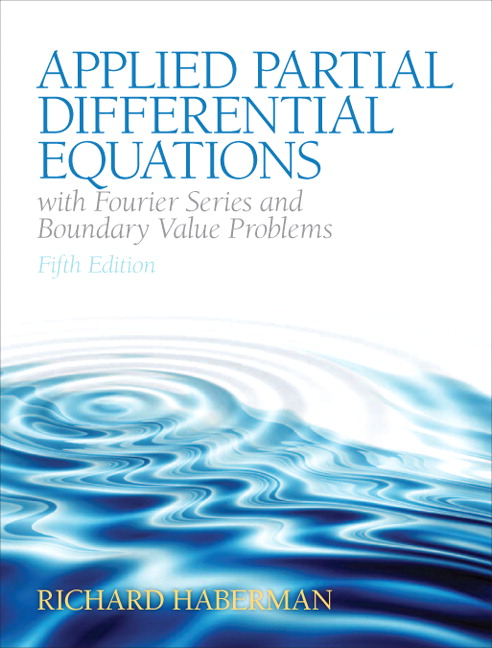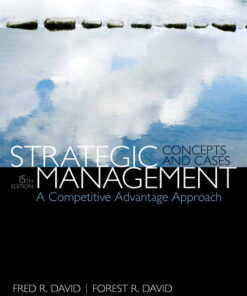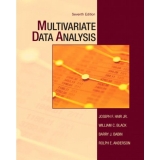Solution Manual for Applied Partial Differential Equations with Fourier Series and Boundary Value Problems, 5/E, Richard Haberman, ISBN-10: 0321797051, ISBN-13: 9780321797056
$55.00
Solution Manual for Applied Partial Differential Equations with Fourier Series and Boundary Value Problems, 5/E, Richard Haberman, ISBN-10: 0321797051, ISBN-13: 9780321797056
Downloadable Solution Manual for Applied Partial Differential Equations with Fourier Series and Boundary Value Problems, 5/E, Richard Haberman, ISBN-10: 0321797051, ISBN-13: 9780321797056
This is not an original TEXT BOOK (or Test Bank or original eBook). You are buying Solution Manual. A Solution Manual is step by step solutions of end of chapter questions in the text book. Solution manual offers the complete detailed answers to every question in textbook at the end of chapter. Please download sample for your confidential. All orders are safe, secure and confidential.
Table of Contents
Normal 0 false false false
1. Heat Equation
1.1 Introduction
1.2 Derivation of the Conduction of Heat in a One-Dimensional Rod
1.3 Boundary Conditions
1.4 Equilibrium Temperature Distribution
1.4.1 Prescribed Temperature
1.4.2 Insulated Boundaries
1.5 Derivation of the Heat Equation in Two or Three Dimensions
2. Method of Separation of Variables
2.1 Introduction
2.2 Linearity
2.3 Heat Equation with Zero Temperatures at Finite Ends
2.3.1 Introduction
2.3.2 Separation of Variables
2.3.3 Time-Dependent Equation
2.3.4 Boundary Value Problem
2.3.5 Product Solutions and the Principle of Superposition
2.3.6 Orthogonality of Sines
2.3.7 Formulation, Solution, and Interpretation of an Example
2.3.8 Summary
2.4 Worked Examples with the Heat Equation: Other Boundary Value Problems
2.4.1 Heat Conduction in a Rod with Insulated Ends
2.4.2 Heat Conduction in a Thin Circular Ring
2.4.3 Summary of Boundary Value Problems
2.5 Laplace’s Equation: Solutions and Qualitative Properties
2.5.1 Laplace’s Equation Inside a Rectangle
2.5.2 Laplace’s Equation for a Circular Disk
2.5.3 Fluid Flow Past a Circular Cylinder (Lift)
2.5.4 Qualitative Properties of Laplace’s Equation
3. Fourier Series
3.1 Introduction
3.2 Statement of Convergence Theorem
3.3 Fourier Cosine and Sine Series
3.3.1 Fourier Sine Series
3.3.2 Fourier Cosine Series
3.3.3 Representing f(x) by Both a Sine and Cosine Series
3.3.4 Even and Odd Parts
3.3.5 Continuous Fourier Series
3.4 Term-by-Term Differentiation of Fourier Series
3.5 Term-By-Term Integration of Fourier Series
3.6 Complex Form of Fourier Series
4. Wave Equation: Vibrating Strings and Membranes
4.1 Introduction
4.2 Derivation of a Vertically Vibrating String
4.3 Boundary Conditions
4.4 Vibrating String with Fixed Ends
4.5 Vibrating Membrane
4.6 Reflection and Refraction of Electromagnetic (Light) and Acoustic (Sound) Waves
4.6.1 Snell’s Law of Refraction
4.6.2 Intensity (Amplitude) of Reflected and Refracted Waves
4.6.3 Total Internal Reflection
5. Sturm-Liouville Eigenvalue Problems
5.1 Introduction
5.2 Examples
5.2.1 Heat Flow in a Nonuniform Rod
5.2.2 Circularly Symmetric Heat Flow
5.3 Sturm-Liouville Eigenvalue Problems
5.3.1 General Classification
5.3.2 Regular Sturm-Liouville Eigenvalue Problem
5.3.3 Example and Illustration of Theorems
5.4 Worked Example: Heat Flow in a Nonuniform Rod without Sources
5.5 Self-Adjoint Operators and Sturm-Liouville Eigenvalue Problems
5.6 Rayleigh Quotient
5.7 Worked Example: Vibrations of a Nonuniform String
5.8 Boundary Conditions of the Third Kind
5.9 Large Eigenvalues (Asymptotic Behavior)
5.10 Approximation Properties
6. Finite Difference Numerical Methods for Partial Differential Equations
6.1 Introduction
6.2 Finite Differences and Truncated Taylor Series
6.3 Heat Equation
6.3.1 Introduction
6.3.2 A Partial Difference Equation
6.3.3 Computations
6.3.4 Fourier-von Neumann Stability Analysis
6.3.5 Separation of Variables for Partial Difference Equations and Analytic Solutions of Ordinary Difference Equations
6.3.6 Matrix Notation
6.3.7 Nonhomogeneous Problems
6.3.8 Other Numerical Schemes
6.3.9 Other Types of Boundary Conditions
6.4 Two-Dimensional Heat Equation
6.5 Wave Equation
6.6 Laplace’s Equation
6.7 Finite Element Method
6.7.1 Approximation with Nonorthogonal Functions (Weak Form of the Partial Differential Equation)
6.7.2 The Simplest Triangular Finite Elements
7. Higher Dimensional Partial Differential Equations
7.1 Introduction
7.2 Separation of the Time Variable
7.2.1 Vibrating Membrane: Any Shape
7.2.2 Heat Conduction: Any Region
7.2.3 Summary
7.3 Vibrating Rectangular Membrane
7.4 Statements and Illustrations of Theorems for the Eigenvalue Problem ?2f + ?f = 0
7.5 Green’s Formula, Self-Adjoint Operators and Multidimensional Eigenvalue Problems
7.6 Rayleigh Quotient and Laplace’s Equation
7.6.1 Rayleigh Quotient
7.6.2 Time-Dependent Heat Equation and Laplace’s Equation
7.7 Vibrating Circular Membrane and Bessel Functions
7.7.1 Introduction
7.7.2 Separation of Variables
7.7.3 Eigenvalue Problems (One Dimensional)
7.7.4 Bessel’s Differential Equation
7.7.5 Singular Points and Bessel’s Differential Equation
7.7.6 Bessel Functions and Their Asymptotic Properties (near z = 0)
7.7.7 Eigenvalue Problem Involving Bessel Functions
7.7.8 Initial Value Problem for a Vibrating Circular Membrane
7.7.9 Circularly Symmetric Case
7.8 More on Bessel Functions
7.8.1 Qualitative Properties of Bessel Functions
7.8.2 Asymptotic Formulas for the Eigenvalues
7.8.3 Zeros of Bessel Functions and Nodal Curves
7.8.4 Series Representation of Bessel Functions
7.9 Laplace’s Equation in a Circular Cylinder
7.9.1 Introduction
7.9.2 Separation of Variables
7.9.3 Zero Temperature on the Lateral Sides and on the Bottom or Top
7.9.4 Zero Temperature on the Top and Bottom
7.9.5 Modified Bessel Functions
7.10 Spherical Problems and Legendre Polynomials
7.10.1 Introduction
7.10.2 Separation of Variables and One-Dimensional Eigenvalue Problems
7.10.3 Associated Legendre Functions and Legendre Polynomials
7.10.4 Radial Eigenvalue Problems
7.10.5 Product Solutions, Modes of Vibration, and the Initial Value Problem
7.10.6 Laplace’s Equation Inside a Spherical Cavity
8. Nonhomogeneous Problems
8.1 Introduction
8.2 Heat Flow with Sources and Nonhomogeneous Boundary Conditions
8.3 Method of Eigenfunction Expansion with Homogeneous Boundary Conditions (Differentiating Series of Eigenfunctions)
8.4 Method of Eigenfunction Expansion Using Green’s Formula (With or Without Homogeneous Boundary Conditions)
8.5 Forced Vibrating Membranes and Resonance
8.6 Poisson’s Equation
9. Green’s Functions for Time-Independent Problems
9.1 Introduction
9.2 One-dimensional Heat Equation
9.3 Green’s Functions for Boundary Value Problems for Ordinary Differential Equations
9.3.1 One-Dimensional Steady-State Heat Equation
9.3.2 The Method of Variation of Parameters
9.3.3 The Method of Eigenfunction Expansion for Green’s Functions
9.3.4 The Dirac Delta Function and Its Relationship to Green’s Functions
9.3.5 Nonhomogeneous Boundary Conditions
9.3.6 Summary
9.4 Fredholm Alternative and Generalized Green’s Functions
9.4.1 Introduction
9.4.2 Fredholm Alternative
9.4.3 Generalized Green’s Functions
9.5 Green’s Functions for Poisson’s Equation
9.5.1 Introduction
9.5.2 Multidimensional Dirac Delta Function and Green’s Functions
9.5.3 Green’s Functions by the Method of Eigenfunction Expansion and the Fredholm Alternative
9.5.4 Direct Solution of Green’s Functions (One-Dimensional Eigenfunctions)
9.5.5 Using Green’s Functions for Problems with Nonhomogeneous Boundary Conditions
9.5.6 Infinite Space Green’s Functions
9.5.7 Green’s Functions for Bounded Domains Using Infinite Space Green’s Functions
9.5.8 Green’s Functions for a Semi-Infinite Plane (y > 0) Using Infinite Space Green’s Functions: The Method of Images
9.5.9 Green’s Functions for a Circle: The Method of Images
9.6 Perturbed Eigenvalue Problems
9.6.1 Introduction
9.6.2 Mathematical Example
9.6.3 Vibrating Nearly Circular Membrane
9.7 Summary
10. Infinite Domain Problems: Fourier Transform Solutions of Partial Differential Equations
10.1 Introduction
10.2 Heat Equation on an Infinite Domain
10.3 Fourier Transform Pair
10.3.1 Motivation from Fourier Series Identity
10.3.2 Fourier Transform
10.3.3 Inverse Fourier Transform of a Gaussian
10.4 Fourier Transform and the Heat Equation
10.4.1 Heat Equation
10.4.2 Fourier Transforming the Heat Equation: Transforms of Derivatives
10.4.3 Convolution Theorem
10.4.4 Summary of Properties of the Fourier Transform
10.5 Fourier Sine and Cosine Transforms: The Heat Equation on Semi-Infinite Intervals
10.5.1 Introduction
10.5.2 Heat Equation on a Semi-Infinite Interval I
10.5.3 Fourier Sine and Cosine Transforms
10.5.4 Transforms of Derivatives
10.5.5 Heat Equation on a Semi-Infinite Interval II
10.5.6 Tables of Fourier Sine and Cosine Transforms
10.6 Worked Examples Using Transforms
10.6.1 One-Dimensional Wave Equation on an Infinite Interval
10.6.2 Laplace’s Equation in a Semi-Infinite Strip
10.6.3 Laplace’s Equation in a Half-Plane
10.6.4 Laplace’s Equation in a Quarter-Plane
10.6.5 Heat Equation in a Plane (Two-Dimensional Fourier Transforms)
10.6.6 Table of Double-Fourier Transforms
10.7 Scattering and Inverse Scattering
11. Green’s Functions for Wave and Heat Equations
11.1 Introduction
11.2 Green’s Functions for the Wave Equation
11.2.1 Introduction
11.2.2 Green’s Formula
11.2.3 Reciprocity
11.2.4 Using the Green’s Function
11.2.5 Green’s Function for the Wave Equation
11.2.6 Alternate Differential Equation for the Green’s Function
11.2.7 Infinite Space Green’s Function for the One-Dimensional Wave Equation and d’Alembert’s Solution
11.2.8 Infinite Space Green’s Function for the Three-Dimensional Wave Equation (Huygens’ Principle)
11.2.9 Two-Dimensional Infinite Space Green’s Function
11.2.10 Summary
11.3 Green’s Functions for the Heat Equation
11.3.1 Introduction
11.3.2 Non-Self-Adjoint Nature of the Heat Equation
11.3.3 Green’s Formula
11.3.4 Adjoint Green’s Function
11.3.5 Reciprocity
11.3.6 Representation of the Solution Using Green’s Functions
11.3.7 Alternate Differential Equation for the Green’s Function
11.3.8 Infinite Space Green’s Function for the Diffusion Equation
11.3.9 Green’s Function for the Heat Equation (Semi-Infinite Domain)
11.3.10 Green’s Function for the Heat Equation (on a Finite Region)
12. The Method of Characteristics for Linear and Quasilinear Wave Equations
12.1 Introduction
12.2 Characteristics for First-Order Wave Equations
12.2.1 Introduction
12.2.2 Method of Characteristics for First-Order Partial Differential Equations
12.3 Method of Characteristics for the One-Dimensional Wave Equation
12.3.1 General Solution
12.3.2 Initial Value Problem (Infinite Domain)
12.3.3 D’alembert’s Solution
12.4 Semi-Infinite Strings and Reflections
12.5 Method of Characteristics for a Vibrating String of Fixed Length
12.6 The Method of Characteristics for Quasilinear Partial Differential Equations
12.6.1 Method of Characteristics
12.6.2 Traffic Flow
12.6.3 Method of Characteristics (Q=0)
12.6.4 Shock Waves
12.6.5 Quasilinear Example
12.7 First-Order Nonlinear Partial Differential Equations
12.7.1 Eikonal Equation Derived from the Wave Equation
12.7.2 Solving the Eikonal Equation in Uniform Media and Reflected Waves
12.7.3 First-Order Nonlinear Partial Differential Equations
13. Laplace Transform Solution of Partial Differential Equations
13.1 Introduction
13.2 Properties of the Laplace Transform
13.2.1 Introduction
13.2.2 Singularities of the Laplace Transform
13.2.3 Transforms of Derivatives
13.2.4 Convolution Theorem
13.3 Green’s Functions for Initial Value Problems for Ordinary Differential Equations
13.4 A Signal Problem for the Wave Equation
13.5 A Signal Problem for a Vibrating String of Finite Length
13.6 The Wave Equation and its Green’s Function
13.7 Inversion of Laplace Transforms Using Contour Integrals in the Complex Plane
13.8 Solving the Wave Equation Using Laplace Transforms (with Complex Variables)
14. Dispersive Waves: Slow Variations, Stability, Nonlinearity, and Perturbation Methods
14.1 Introduction
14.2 Dispersive Waves and Group Velocity
14.2.1 Traveling Waves and the Dispersion Relation
14.2.2 Group Velocity I
14.3 Wave Guides
14.3.1 Response to Concentrated Periodic Sources with Frequency ?f
14.3.2 Green’s Function If Mode Propagates
14.3.3 Green’s Function If Mode Does Not Propagate
14.3.4 Design Considerations
14.4 Fiber Optics
14.5 Group Velocity II and the Method of Stationary Phase
14.5.1 Method of Stationary Phase
14.5.2 Application to Linear Dispersive Waves
14.6 Slowly Varying Dispersive Waves (Group Velocity and Caustics)
14.6.1 Approximate Solutions of Dispersive Partial Differential Equations
14.6.2 Formation of a Caustic
14.7 Wave Envelope Equations (Concentrated Wave Number)
14.7.1 Schrödinger Equation
14.7.2 Linearized Korteweg-de Vries Equation
14.7.3 Nonlinear Dispersive Waves: Korteweg-deVries Equation
14.7.4 Solitons and Inverse Scattering
14.7.5 Nonlinear Schrödinger Equation
14.8 Stability and Instability
14.8.1 Brief Ordinary Differential Equations and Bifurcation Theory
14.8.2 Elementary Example of a Stable Equilibrium for a Partial Differential Equation
14.8.3 Typical Unstable Equilibrium for a Partial Differential Equation and Pattern Formation
14.8.4 Ill posed Problems
14.8.5 Slightly Unstable Dispersive Waves and the Linearized Complex Ginzburg-Landau Equation
14.8.6 Nonlinear Complex Ginzburg-Landau Equation
14.8.7 Long Wave Instabilities
14.8.8 Pattern Formation for Reaction-Diffusion Equations and the Turing Instability
14.9 Singular Perturbation Methods: Multiple Scales
14.9.1 Ordinary Differential Equation: Weakly Nonlinearly Damped Oscillator
14.9.2 Ordinary Differential Equation: Slowly Varying Oscillator
14.9.3 Slightly Unstable Partial Differential Equation on Fixed Spatial Domain
14.9.4 Slowly Varying Medium for the Wave Equation
14.9.5 Slowly Varying Linear Dispersive Waves (Including Weak Nonlinear Effects)
14.10 Singular Perturbation Methods: Boundary Layers Method of Matched Asymptotic Expansions
14.10.1 Boundary Layer in an Ordinary Differential Equation
14.10.2 Diffusion of a Pollutant Dominated by Convection
Bibliography
Answers to Starred Exercises
Index
Be the first to review “Solution Manual for Applied Partial Differential Equations with Fourier Series and Boundary Value Problems, 5/E, Richard Haberman, ISBN-10: 0321797051, ISBN-13: 9780321797056” Cancel reply
Related products
Solution Manual
Solution Manual
Understanding Business Nickels 10th Edition Solutions Manual












Reviews
There are no reviews yet.